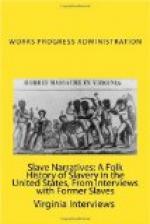George Fortman has friends at Dauson Springs, Grayson Springs, and other Kentucky resorts. He has been a citizen of Evansville for thirty-five years and has had business connections here for sixty-two years. He janitored for eleven years for the Lockyear Business College, but his days of usefulness are over. He now occupies a room at Bellemeade Ave. and Garvin St. and his only exercise consists of a stroll over to the Lincoln High School. There he enjoys listening to the voices of the pupils as they play about the campus. “They are free”, he rejoices. “They can build their own destinies, they did not arrive in this life by births of unsatisfactory circumstances. They have the world before them and my grandsons and granddaughters are among them.”
Federal Writers’ Project
of the W.P.A.
District #6
Marion County
Anna Pritchett
1200 Kentucky Avenue
Folklore
John Henry Gibson—ex-slave
Colton Street
John Henry Gibson was born a slave, many years ago,
in Scott County,
N.C.
His old master, John Henry Bidding, was a wealthy farmer; he also owned the hotel, or rooming house.
When court was in session the “higher ups” would come to this house, and stay until the court affairs were settled.
Mr. Bidding, who was very kind to his slaves, died when John Gibson was very young. All slaves and other property passed on to the son, Joseph Bidding, who in turn was as kind as his father had been.
Gibson’s father belonged to General Lee Gibson, who was a neighboring farmer. He saw and met Miss Elizabeth Bidding’s maid; they liked each other so very much, Miss Elizabeth bought him from General Gibson, and let him have her maid as his wife. The wife lived only a short time, leaving a little boy.
After the Civil war, a white man, by the name of Luster, was comming to Ohio, brought John Gibson with him. They came to Indianapolis, and Gibson liked it so well, he decided to remain; Mr. Luster told him if he ever became dissatisfied to come on to Ohio to him, but he remained in Indianapolis until 1872, then went back south, married, came back, and made Indianapolis his home.
Interviewer’s Comment
Mr. Gibson is very old, but does not know his exact age. He fought in the Civil war, and said he could not be very young to have done that.
His sight is very nearly gone, can only distinguish light and dark.
He is very proud of his name, having been named for his old master.
Submitted January 24, 1938
Indianapolis, Indiana
Submitted by:
William Webb Tuttle
District No. 2
Muncie, Indiana
Negro slaves in Delaware county
Mrs. Betty Guwn
Mrs. Hattie Cash, daughter, residing
at 1101 East Second Street
Muncie, Indiana




